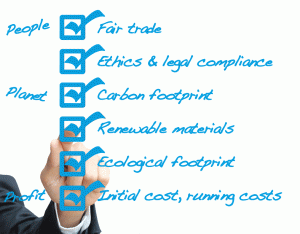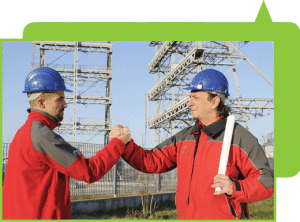Your business may be in a position to rebuild, redesign or refit its facilities. Or you may be setting up a new facility and have input into the design features and service contracts. These are opportunities to optimise your sustainability performance by reducing energy and water consumption, installing water and waste recycling systems and purchasing plant and equipment to minimse waste and emissions.
However, you may not be in a position to look globally or make ‘big ticket’ improvements to your physical infrastructure. Even so you might be able to improve how the lighting and heating systems operate, set up waste recycling systems or factor sustainability measures into scheduled maintenance and upgrade projects. These can have a significant impact on sustainability performance and the bottom line over time.
Sustainable practice
Maintenance
Regular maintenance of your systems and equipment will ensure that it is running at its most efficient. Air-conditioning systems with accurate thermostat controls will ensure that they only ‘kick in’ when needed. Well maintained production and transport equipment can mean maximum output for minimum energy use and a reduction in downtime. It will also be safer and will reduce the risk of environmental incidents and personal injury.
Setting the ‘technical specification’ of equipment to be maintained is a crucial step. If the specification is written in terms of minimum cost for maximum availability then that is where the emphasis will be. If you include sustainable objectives such as lower use of energy or other utilities, less waste generated and quieter operation then these factors will also be taken into consideration in the maintenance regime.
Heating and cooling
You may want to focus on improving the energy efficiency of your buildings, facilities and service systems rather than your day to day operational resource efficiency (see Operational resource efficiency). These improvements can deliver significant energy and cost savings and reduce waste and waste management costs.
You could make sure that you have effective insulation to reduce heat loss during winter and reduce the need for air conditioning in summer.
Your air-conditioning system may generate some condensation which can be captured and used to water garden beds during summer. If you have high water costs you might want to capture rain water or run off to reduce these costs. In some cases you might be able to reconfigure existing plumbing to capture or divert water directly to gardens or toilets. Or you may want to invest in bigger scale projects to capture, treat and recycle water for use in your production processes.
Some state and local governments may have funding programs to support these capital expenditure projects.
Lighting, heating and cooling systems are usually not needed when your business is not operating. You may be able to get your staff to turn things off and back on as needed. However you might want to install automated systems to ensure that it happens every time and on schedule.
Procurement and services
You might consider all of your purchasing and service contracts within your supply chain or value chain decision making. If not you can apply a similar approach by including sustainability factors in selecting cleaning and building maintenance services and purchase of furniture, fit outs, equipment and machinery. See Sustainable supply chain.
Design and build
If you are planning new buildings or major redesign projects you may be able to include energy efficiency features. Your designers and architects will be able to advise on placement of windows for natural lighting and to make the best use of the sun to reduce winter heating and summer cooling costs. For example good solar design can capture solar energy coming in through windows and combine this with tiled floors and masonry walls that store and then reradiate the heat.
For example good solar design can capture solar energy coming in through windows and combine this with tiled floors and masonry walls that store and then reradiate the heat.
They can also advise on which types of windows and window coverings will make a difference to heating and cooling costs.
There may also be opportunities to harness the heat generated by your business processes to help to heat the buildings or even to sell to local businesses for their heating needs. These are usually referred to as recovery or cogeneration systems. See Process improvement.

Furnishings and refit
Carpets have low heat conduction and are natural thermal insulators. Fitting out areas with carpet can help to retain heat in a room therefore saving energy. In comparison smooth floor coverings can disperse as much as 10% of the heat in a room increasing the amount of energy needed to maintain a comfortable temperature.
You may have already tried to get workers to turn off the lights when they are the last to leave a room. Motion sensitive lights can be more effective because they will automatically turn themselves off when there has been no motion for a set period of time. Another simple lighting option is to ensure that every light has its own light switch, rather than having a few switches that turn on a bank of lights that may not be needed.
You may want to set guidelines for when to replace big ticket items and for selecting replacements. Is new carpet to match a colour scheme acceptable if the carpet is still in good condition? Are new furnishings and fittings likely to be out of fashion before they are worn out? What materials are used, what is their useful life expectancy and how can they be disposed of?
Again carpet is a good example. It is estimated that millions of square metres of carpet are disposed of every year and most of it is left to rot in landfill. It takes 50 years for natural fibres such as wool to break down and 250,000 years for man-made fibres such as nylon to degrade.
Managing your performance
There are many areas you could focus your efforts to improve your facility’s sustainability performance. Your approach will depend on factors such as the size of your business, facility management arrangements, capital expenditure budgets, your immediate needs and long term goals.
Things to think about include:
- Rates of return and payback periods for technology and infrastructure projects
- Researching whether any government funding or incentives are available for energy and water saving projects
- Establishing procedures and guidelines that reflect your priorities and sustainability targets
- Legislation and regulations that may apply to your projects
- Design features, materials, new technologies, renewable energy, cogeneration options that might be available.

